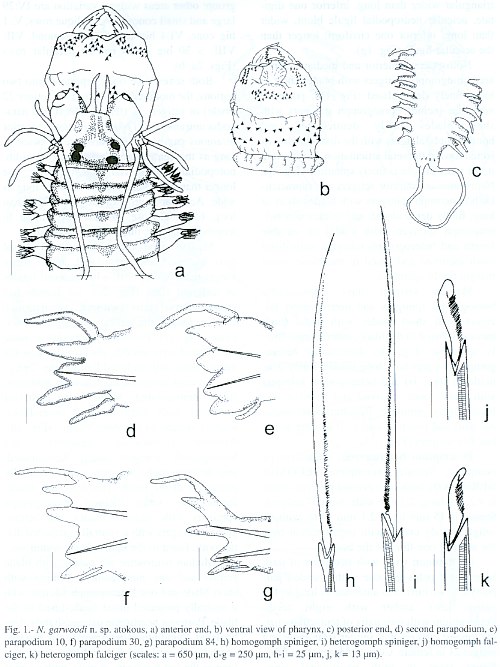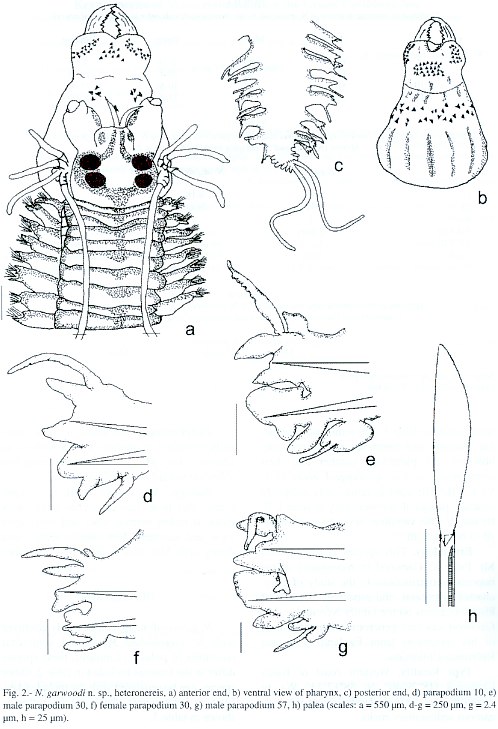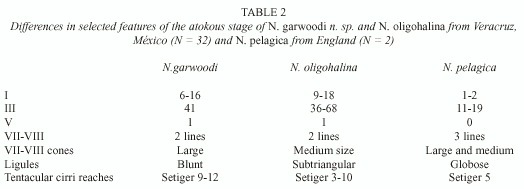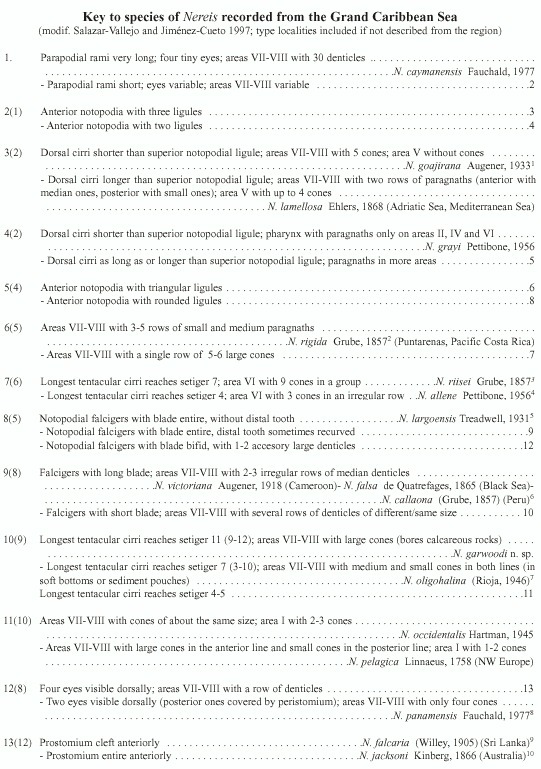Services on Demand
Journal
Article
Indicators
-
 Cited by SciELO
Cited by SciELO -
 Access statistics
Access statistics
Related links
-
 Similars in
SciELO
Similars in
SciELO  uBio
uBio
Share
Revista de Biología Tropical
On-line version ISSN 0034-7744Print version ISSN 0034-7744
Rev. biol. trop vol.51 n.1 San José Mar. 2003
Abstract
Nereis garwoodi n. sp. is described on the basis of eight syntype specimens (six atokous and two heteronereis) collected in Bahía Chetumal, Mexican Caribbean coast, and the variability in the paragnath numbers in the pharynx is established using 180 specimens; paragnath numbers are I:10(SD=1.9); II:30 (SD=2.6); III:41 (SD=5.2); IV:29 (SD=3.5), V:1, VI:4, VII-VIII: >30. Its eyes are big and its longest tentacular cirri reaches setiger 11. A revised key to species of Nereis recorded from the Grand Caribbean Sea is included.
Key words: Taxonomy, morphological variation, Nereis oligohalina.
Nereididae is one of the most important polychaete family due to its diversity and abundance in almost all marine bottoms. Furthermore, some species are economically important and can be mantained in the laboratory rather easily. Some species in the family are capable of living in highly variable saline conditions and other species can be employed as water quality environmental indicators (Wu et al. 1985).
Nereis Linnaeus is set apart from other nereidids because it has conical paragnaths in both pharyngeal rings and homogomph falcigers in posterior setigers (Wu et al. 1985). From the more than 130 described species in the genus, about half are recorded from estuarine environments and there is a growing evidence of a high degree of speciation within that environment (Röhner et al. 1997, Sato and Masuda 1997). In the Grand Caribbean Sea, 14 species have been recorded (Salazar-Vallejo 1996), although there remains some confusion as to the identification of particular species (see key below).
In this work we describe an estuarine species of nereidid that bores in calcareous sedimentary rocks in shallow water in Chetumal Bay; two epitoke specimens were collected and are also described herein. Further, we present an updated and revised key to Nereis in the Grand Caribbean Sea.
Material and methods
Rocks were collected from the bottom at 1 m in depth and five samplings were carried out (June to October, 1999) in the bay of Chetumal; eight organisms were employed for the description and 180 for the analysis of variation; each rock was broken into pieces and the specimens were placed in 96% ethanol to force them to expel their pharynx. The specimens were then fixed in a 10% formaline solution in sea water, washed in tap water for 24 h, and were preserved in 70% ethanol.
Type material was selected using the larger and best preserved specimens from the same sample. Syntypes were deposited as follows: two atokous specimens in the Museum National dHistoire Naturelle, Paris, one atokous specimen in The Natural History Museum, London, one atokous specimen in the Zoological Museum of the University of Copenhagen, one atokous specimen in the Naturhistorischen Museum, Vienna, and three specimens (one atokous and two heteronereis) in the Reference Collection of ECOSUR. Width was measured at setiger 5; anterior (setiger 10), median (setiger 30), and posterior (atokous, setiger 84; heteronereis, setiger 57) parapodia were dissected. Variability was analysed using only complete specimens with Statistica.
Other reference materials studied were Nereis pelagica Linnaeus collected in England and identified by P. R. Garwood (ECOSUR NERE-18), and N. oligohalina (Rioja) collected in Estero Casitas, Nautla, Veracruz (UANL-3918), collected by A. Contreras Arguieta and identified by J. Angel de León-González. The key includes species described from temperate waters as well as from other regions of the world; the specimens in the Caribbean region might belong to the same species but we have serious doubts about its potential or realized widespread distribution. To further stimulate consideration of relationships among these species, we have included type localities in parenthesis for each name.
Results
Material examined: México, Mexican Caribbean coast, Bahía Chetumal, 24 September 1999, eight syntypes: six atokous and two heteronereis. Another 180 complete specimens were studied in order to evaluate the variability in paragnath numbers in the pharynx, they were collected in the same locality in different dates (26 in June, 21 in July, 20 in August, 26 in September, and 87 in October).
Description atokous: syntype complete (MNHN-000), 34 mm long, 2.7 mm wide (including parapodia), with 95 setigers. Body cream with black pigmentation present dorsally on the first one-third of the body; pigment in thin transverse bands located on the anterior portion of each segment, each band provided with a middorsal projection toward the following segment. In the prostomium, two longitudinal bands extend from the antennae toward the eyes, leaving the central area colorless; there are two pairs of circular spots, one on the narrow anterior portion of the prostomium and the other on the medial surface of the palps (Fig. 1a)
Prostomium with two pairs of subequal, dark eyes; palps thick biarticulated, palpostyles rounded; antennae cirriform slightly passing the palpostyles. Jaws amber with eight teeth of similar size. Peristomium with four pairs of tentacular cirri, the longest ones reaching setiger 12. Paragnaths in the following arrangement: I:15 cones in a group, II:32 median cones forming 2-3 lines in an arc, III:45 small and median cones in a rectangle, IV:36 small and median cones in 4 lines, V:1 large cone, VI:4 large cones in a diamond, VII-VIII: > 30 large cones in two irregular rows (Fig. 1b)
First two parapodia uniramous, the remaining biramous. Second parapodium with dorsal cirrus one-third longer than the ventral cirrus and about the same width; there are three ligules, the neuroacicular ligule about one-half the size of the others (Fig. 1d). Remaining parapodia with dorsal cirri wider and three times longer than ventral cirri. Anterior parapodia with superior notopodial ligule triangular, slightly longer than wide, inferior notopodial ligule globose; superior neuropodial ligule blunt, wider than long, inferior ligule blunt, longer than wide; ventral cirri thin, bout one-third the length of the dorsal cirri (Fig. 1e). Median parapodia with superior notopodial ligule digitate, inferior ligule blunt, longer than wide, acicular neuropodial ligule wider than long, slightly triangular, inferior ligule longer than wide (Fig. 1f). Posterior parapodia with enlarged dorsal cirri and notopodial ligule; superior notopodial ligule triangular wider than long, inferior one digitate, acicular neuropodial ligule blunt, wider than long, inferior one cirriform longer than the acicular ligule (Fig. 1g).
Notosetae in anterior and median regions are homogomph spinigers with blades short to long, finely denticulated (Fig. 1h); posterior notosetae include homogomph spinigers with short blades finely denticulated and homogomph falcigers with the distal tooth projected toward the setal articulation and fused to it, the inner margin is finely spinulose (Fig. 1j). Neurosetae on anterior setigers are supracicular homogomph spinigers with blades short or long, finely denticulated, andinfracicular heterogomph spinigers with blades of variable length and heterogomph falcigers with distal tooth incurved and fused to the blade, inner margin finely spinulose.
Median setigers have supracicular homogomph spinigers and heterogomph falcigers with short blades with distal tooth incurved, fused to the blade, inner margin finely spinulose (Fig. 1k). Infracicular heterogomph spinigers with long blades, finely denticulated (Fig. 1i) and heterogomph falcigers with distal tooth incurved and fused to the blade, finely spinulose. Pygidium with terminal anus and two thin anal cirri as long as the last five setigers (Fig. 1c ).

Description heteronereis: male syntype complete, female incomplete (ECOSUR NERE-S000), both with everted pharynx; male is 9.2 mm long, 2.3 mm wide, with 67 setigers, female is 15 mm long, 2.1 mm wide, with 61 setigers; body cream with pigmentation over the anterior one-third of the body.
Prostomium wide with two pairs of dark large eyes; palps globose with rounded palpostyles, two cirriform antennae as long as the palps; jaws amber with eight teeth. Peristomium with four pairs of tentacular cirri, the longest cirri reaches setiger 19 in male and setiger 21 in female. Conical paragnaths of different sizes in both pharyngeal rings (male/female), I:14/7 median cones in a triangle, II:26/25 median and small cones in an arc, III:47/46 median and small cones in oval group; other areas without variation are IV:29 large and small cones in 4-3 oblique rows, V: 1 big cone, VI:4 big cones in a diamond, VII-VIII: > 30 big cones in two irregular rows (Figs. 2a, b).
Both sexes have body separated into two regions, the modified region starts in setiger 22 (male) or setiger 21 (female). First two parapodia uniramous, all others biramous. Anterior biramous parapodia with dorsal cirri twice as long as the ventral cirri, but similar in width; notopodial ligules triangular, superior one longer than wide, inferior one about as long as wide. Acicular neuropodial ligule wider than long, blunt, globose, inferior one similar in length but narrow; three acicula (Fig. 2d).
Median parapodia of male with dorsal cirri widened and crenulated, three times longer than ventral cirri, with widened ligules of different sizes (Fig. 2e); the female has smooth dorsal cirri (without crenulations), twice as long as the ventral cirri; with two aciculae (Fig. 2f). Posterior parapodia of male with dorsal cirri smooth, about as long as the ventral cirri, with widened ligules (Fig. 2g). Anterior notosetae homogomph spinigers, finely denticulated. Median and posterior notosetae with padlle shaped appendages, slighlty serrate on the inner margin (Fig. 2h).
Anterior supracicular neurosetae are homogomph spinigers, finely denticulated, and heterogomph falcigers with a ventrally projected distal tooth, fused to the blade. Infracicular setae include heterogomph spinigers with variable blades and hetero-gomph falcigers with a ventrally projected distal tooth, fused to the blade, finely spinulose. Median neurosetae are paleae with blade serrate and one homogomph spiniger with short blade and one heterogomph falciger with a ventrally projected distal tooth, fused to the blade. Posterior neurosetae paleae, slightly denticulated.
Pygidium with terminal anus and two ventral anal cirri, cirri thin and long, can be as long as the last 8 setigers in male, with a series of anal papillae arranged as a fan (Fig. 2c).

Variation: the variation in merisitic features of 180 specimens of N. garwoodi n. sp is summarized in table 1. The number of parapodia, biomass and length are widely variable; however, the paragnath number and their arrangement in four pharyngeal areas (V:1, VI:4, VII-VIII: >30) is remarkably stable. In contrast, paragnath numbers vary in areas I, II, III and IV. This variation, however, is not related to body length.
Etymology. This species is named after Mr. Peter R. Garwood in recognition of his important contributions to the study of polychaetes in general, and especially because of his publications on the family Nereididae. Mr. Garwood was very generous in donating some of his specimens from England to Ecosur Reference Collection.
Type locality. Western coast of Bahía Chetumal (18º2940" N, 88º1723" W), in mixed bottoms at 1 m depth, boring into calcareous sedimentary rocks.
Distribution. N. garwoodi n. sp. is apparently restricted to shallow mixed bottoms in Chetumal Bay, Mexican Caribbean; being less abundant toward the north of the bay.
Biology. N. garwoodi n. sp. is a cryptic species that bores into calcareous sedimentary rocks. It makes mucous tubes and feeds upon algae and sediment. Heteronereis were found during April, May, June, September and October.



Discussion
N. garwoodi n. sp. can be easily confused with N. oligohalina Rioja and somewhat resembles N. pelagica Linnaeus; these species differ in the features included in table 2. Other species can be separated with the included key. Even in heteronereis, these species differ as shown in table 3.
1) This might include Paraleonnates guadalupensis Amoureux (1985).
2) The description by Augener (1906) differs from the original; in the Caribbean form the longest tentacular cirri reaches setiger 2, while in the original description (Grube 1857), the longest cirri reaches setiger 9.
3) This species is regarded as pan-neotropical (Zottoli & Long 1988) and has been recorded in California and the Gulf of California as N. ambiguus Treadwell (1937) and in the NW Atlantic as N. paucidentata Treadwell (1939); they could be different species.
4) In an earlier key (Salazar-Vallejo & Jiménez-Cueto 1997), this species could not be separated but new information from the redescription by de León-González et al. (1999), allows its recognition.
5) This species is different from both N. occidentalis and N. oligohalina; besides its lens-shaped blade in posterior notopodial falcigers, it has very short tentacular cirri, the longest one barely reaches the tip of palps. This approaches N. largoensis to N. pelagica but they differ in the size of the eyes, being smaller and free from each other in N. largoensis while in N. pelagica are larger and each eye in the lateral pair is nearly fused to each other.
6) The order of the species indicates their probability of being present in this region and not any synonymy because they could be different species.
7) Most estuarine records of N. occidentalis Hartman or N. pelagica from the Southwestern Gulf of Mexico, might belong to this species, which is common in sediments accumulated in or around oysters.
8) The record by San Martín (1994) for Cuban waters belongs to this species; it was a mistake to contradict that in our previous key (Salazar-Vallejo & Jiménez-Cueto 1997) and has been pointed out by de León-González et al. (1999).
9) In the previous key (Salazar-Vallejo & Jiménez-Cueto 1997), N. kauderni was included. The right name should be N. falcaria Willey (1905); it was described in Ceratonereis because of its cleft prostomium. Its synonymy was suspected by Fauvel (1953:188) and was indicated by Hartman (1959).
10) Other similar species can be found in the review by Hutchings & Turvey (1982).

Acknowledgments
J. Rolando Bastida-Zavala, Luis F. Carrera-Parra, and Patricia Salazar made useful suggestions to the manuscript; Jesús A. de León-González provided some specimens for comparison and offered useful suggestions. Peter R. Garwood donated part of his reference collection to help us understand the supposed presence of European species in Caribbean waters. Our colleagues in the Bentos y Contaminación research group in ECOSUR came to the field with us and helped a lot there. Scott Monks helped with the language. Funding for this project was provided by SEMARNAP and by CONACYT (32529T).
Resumen
Se describe N. garwoodi n. sp. con base en ocho ejemplares sintipos (seis atokos y dos heteronereis) recolectados en el sublitoral (1 m) en la bahía de Chetumal y se define la variación en los paragnatos de las áreas diag-nósticas de la faringe usando 180 ejemplares, las cuáles son I:10(SD=1.9); II:30 (SD=2.6); III:41 (SD=5.2); IV:29 (SD=3.5), V:1, VI:4, VII-VIII:>30. Se caracteriza por tener un cirro tentacular que alcanza el setígero 11. Se incluye una clave revisada para las especies de Nereis registradas en el Gran Caribe.
References
Amoureux, L. 1985. Annélides benthiques récoltées à lentrée de la lagune de la Manche-à-Eau, Guadeloupe (Antilles). Bull. Mus. Natl. Hist. Nat. Paris 4e sér. 7, A(1): 93-107. [ Links ]
Augener, H. 1906. Reports on the results of dredging, under the supervision of Alexander Agassiz, in the Gulf of Mexico and the Caribbean Sea, and on the East coast of the United States, 1877 to 1880, by the U.S. Coast Survey Steamer "Blake", Lieut. Commander C.D. Sigsbee, U.S.N., and Commander J.R. Bartlett, 42. Westindische Polychaeten. Bull. Mus. Comp. Zool. Harv. 43: 91-197.
Chambers, S.J. & P.R. Garwood. 1992. Polychaetes from Scottish Waters, 3. Family Nereidae. National Museum of Scotland, Edinburgh, 65 p. [ Links ]
De León-González, J.A., V. Solís-Weiss & V. Ochoa Rivera. 1999. Nereidids (Polychaeta) from the Caribbean Sea and adjacent Coral Islands of the southern Gulf of Mexico. Proc. Biol. Soc. Wash. 112: 667-681. [ Links ]
Fauvel, P. 1953. The Fauna of India including Pakistan, Ceylon, Burma and Malaya: Annelida Polychaeta. Indian, Allahabad, 507 p. [ Links ]
Grube, A.E. 1857. Annulata Örstediana. Enumeratio Annulatorum, quae in itinere per Indiam occiden-talem et Americam centralem annis 1845-1848 suscepto legit cl. A.S. Örsted, adjectis speciebus nonnulis a cl. H. Kröyero in itinere ad Americam meridionalem collectis. Naturhist. Foren. Vidensk. Meddel. 1857: 1-29.
Hartman, O. 1959. Catalogue of the Polychaetous Annelids of the World, 1. Allan Hancock Found. Publ. Occ. Pap. 23: 1-353. [ Links ]
Hutchings, P.A. & S.P. Turvey. 1982. The Nereididae of South Australia. Trans. R. Soc. Austr. 106: 93-144. [ Links ]
Pettibone, M.H. 1956. Some polychaete worms of the families Hesionidae, Syllidae, and Nereidae from the east coast of North America, West Indies, and Gulf of Mexico. J. Wash. Acad. Sci. 46: 281-294.
Rioja, E. 1946. Estudios anelidológicos, 15. Nereidos de agua salobre de los esteros del litoral del Golfo de Mexico. Anal. Inst. Biol. UNAM 17: 205-214. [ Links ]
Röhner, M.R. Bastrop & K. Jürss. 1997. Genetic differentiation in Hediste diversicolor (Polychaeta: Nereididae) from the North Sea and the Baltic Sea. Mar. Biol. 130: 171-180. [ Links ]
Salazar-Vallejo, S.I. 1996. Lista de especies y bibliografía de poliquetos (Polychaeta) del Gran Caribe. Ann. Inst. Biol. UNAM, Ser. Zool. 67: 11-50. [ Links ]
Salazar-Vallejo, S.I. & S. Jiménez-Cueto. 1997. Neréididos (Polychaeta) del Caribe Mexicano con una clave para las especies del Gran Caribe. Rev. Biol. Trop. 44/45: 361-377.
San Martín, G. 1994 (1993). Anélidos poliquetos de la I Expedición Cubano-Española a la Isla de la Juventud y Archipiélago de los Canarreos, 5. Nereididae. Rev. Invest. Mar. 14: 3-9.
Sato, M. & Y. Masuda. 1997. Genetic differentiation in two sibling species of the brackish-water polychaete Hediste japonica complex (Nereididae). Mar. Biol. 130: 163-170. [ Links ]
Treadwell, A.L. 1937. The Templeton Crocker Expedition, 8. Polychaetous annelids from the west coast of Lower California, the Gulf of California and Clarion Island. Zoologica, New York Zool. Soc. 22: 139-162.
Treadwell, A.L. 1939. New polychaetous annelids from New England, Texas and Puerto Rico. Amer. Mus. Novit. 1023: 1-7. [ Links ]
Willey, A. 1905. Report on the Polychaeta collected by Professor Herdman, at Ceylon, in 1902, pp. 243-324. In W.A. Herdman (ed.). Report to the Government of Ceylon on the Pearl Oyster Fisheries of the Gulf of Manaar. Royal Society, Londres.
Wu, B., S. Ruiping & D.J. Yang. 1985. The Nereidae (Polychaetous Annelids) of the Chinese Coast. China Ocean, Beijing & Springer, Berlin. 234 p. [ Links ]
Zottoli, R. & C.D. Long. 1998. Late development of the pan-neotropical Nereis riisei Grube 1857 (Polychaeta: Nereididae). Bull. Mar. Sci. 62: 135-143. [ Links ]
1 Depto. Ecología Acuática, ECOSUR, Apdo. Postal 424, Chetumal QR 77000 México; luiseg@ecosur-qroo.mx














